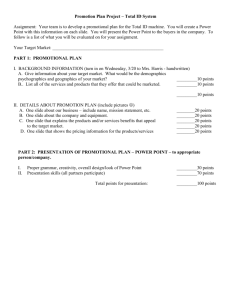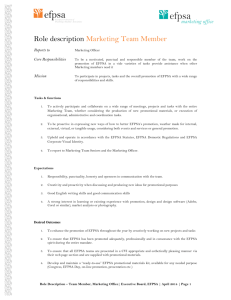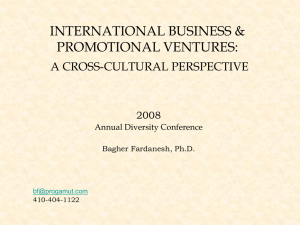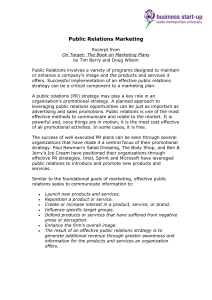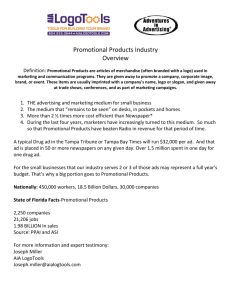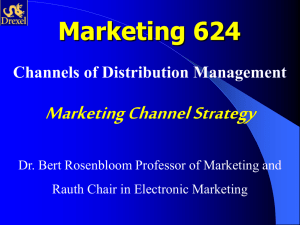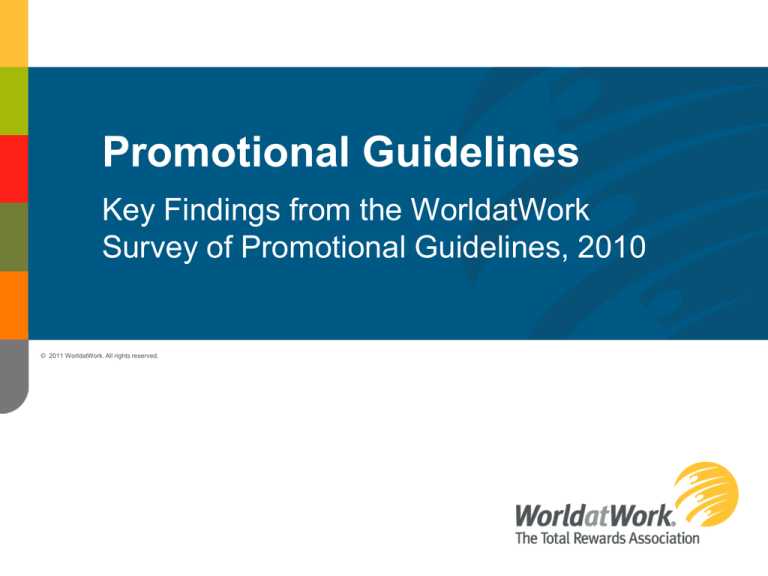
Promotional Guidelines
Key Findings from the WorldatWork
Survey of Promotional Guidelines, 2010
© 2011 WorldatWork. All rights reserved.
Overview
Examine how the current environment impacts
employee satisfaction
Discuss the importance of promotional activity
within total rewards programs
Discuss current promotional practices
survey results
Review implications
Current Environment
Let’s consider current environment
within which we are operating
And a question …
Where does promotional
activity fit within your
total rewards program?
Employee Satisfaction Drivers
Cash
Benefits
Boss Relationship
Work-Life Balance
Promotions/ Career
Development
Recognition
Employee
Satisfaction
Job Losses Declining, But Is
Real Growth on the Horizon?
Jobs* Lost/Created
Monthly Change
Avg. monthly
increase: +138k
* Total non-farm seasonably adjusted
Source: Bureau of Labor Statistics – years 2009 – 2010 (data in 000’s)
Avg. monthly
increase: +49k
Salary Budgets are Recovering,
But Still Historically Low
6.0
salary budget %
5.5
5.0
4.5
4.0
3.5
3.0
2.5
'90
'91
'92
'93
'94
'95
'96
'97
'98
'99
'00
'01
'02
'03
'04
'05
'06
'07
'08
'09
'10
'11?
2.0
Lowest figure
since survey’s
inception
Source: WorldatWork Salary Budget Survey 2010-2011 (exempt salaried budget)
How Do Organizations Generate
Promotional Opportunities?
Organizational Growth
Vacancies as employees
leave for other companies
Retirements
Total Rewards Scorecard
Cash Compensation
Benefits
Boss / Subordinate
Relationship
Total Rewards Scorecard …cont’d
Work-Life Balance
Promotional Opportunities /
Career Development
Recognition
Job Satisfaction Is Declining
65
61.1
% Satisfied
60
55
50
45.3
45
40
'87
'95
Source: Conference Board
'00
'05
'06
'07
'08
'09
Intangible Rewards Remain Important
Education and
training programs
54%
54%
Career / development
opportunities
48%
48%
Flexible work
arrangements
48%
48%
Nonfinancial recognition
60%
40%
40%
40%
52%
57%
57%
Work climate / culture
Work-life balance
80%
50%
53%
48%
48%
60%
40%
20%
% Current Focus
44%
0%
20%
40%
60%
80%
% Greater Focus in Future
Source: The Hay Group and WorldatWork – Next Reward Practices Survey 2009
Methodology
Survey was sent out to
4,947 WorldatWork
members during
September 2010
Response rate of
about 19%
Demographics of
respondents similar to
WorldatWork membership
as a whole
Definition of “Promotion”
Please select all criteria that are REQUIRED
to be considered a promotion. (n= 719)
Increase in
Addition of
Pay Grade,
Higher Level
Band or Level Responsibilities
New Title
New
Department
Other
Definition of “Promotion”
Please select all criteria that are REQUIRED
to be considered a promotion. (n= 719)
32% require both
Increase in
Addition of
Pay Grade,
Higher Level
Band or Level Responsibilities
New Title
New
Department
Other
Size of Promotional Increases
“In 2010 (or current fiscal year), what has been the
average promotional increase, expressed as a percentage,
for each employee class in your organization?”
Employee Type
1
Average Minimum Maximum Mode1
Nonexempt (hourly) (n=504)
7.1%
0%
45%
5%
Exempt (salaried) (n=584)
8.3%
0%
23%
10%
Officers / Executives (n=380)
9.5%
0%
30%
10%
The mode is the number that occurs most frequently in the dataset.
Size of Promotional Increases
by Level of Turnover
Organization Turnover Rate
Nonexempt (hourly)
Exempt (salaried)
Officers / Executives
1
0% - 5%
6% - 10%
11% - 15%
16+%
6.8%
7.0%
6.2%
9.0%1
(n=129)
(n=184)
(n=73)
(n=55)
8.1%
8.2%
8.1%
9.5%
(n=156)
(n=211)
(n=81)
(n=58)
9.5%
9.3%
9.1%
9.8%
(n=97)
(n=136)
(n=56)
(n=46)
Organizations that reported a turnover rate of 16% or higher additionally report a statistically
higher average for nonexempt promotional increase rates.
Determination of Promotional Increases
Option
Pay range for the new position
66%
Rates paid to other employees similarly situated within
the organization
60%
External pay data, if available
36%
Qualifications of the individual, compared to the qualifications
of other employees in the same job within the organization
30%
Performance level of the individual being promoted
29%
A fixed percentage increase for most promotional increases
21%
Number of pay grades between the old position and the
new position
19%
Whether the promotion involves a change from nonexempt
to exempt classification
8%
Number of Promotions Down
“What percentage of employees were promoted in 2009 (or last
fiscal year)? Please specify as a percentage of the number of
total employees.” (n= 477)
“What percentage of employees does your organization usually
promote on an annual basis? Please specify as a percentage of
the number of total employees.” (n= 441)
Employee Type
2009 or last fiscal year
promotions
Typical annual promotions
Average
Minimum
Maximum Mode
7.0%
0%
40%
5%
8.1%1
0%
35%2
10%
3
A paired sample t-test demonstrated a statistically significant difference between annual
promotions given in 2009 and 2010 (p<.000).
4
A value of 98 was submitted and considered excessive. This value was excluded from
the analysis.
Funding of Promotional Increases
“How does your organization fund promotional increases?
(Check all that apply.)” (n= 600)
Option
We budget for promotional increases separate from other
pay increase budgets.
44%
We budget for promotional increases as part of our
merit budget.
24%
We pay for promotional increases with vacancy savings
(savings from vacant positions or during recruitment).
22%
We pay for promotional increases with salary savings (hiring
at a lower rate than previous incumbent).
16%
We budget for promotional increases as part of another budget.
Please specify budget.
13%
We pay for promotional increases out of merit budget, but
merit budget is not inflated to cover promotional increases.
13%
We pay for promotional increases out of another budget, but
the other budget is not inflated to cover promotional increases.
8%
Coordinating Promotions with Merit Increases
“How are merit increases managed
for promoted employees?” (n= 620)
Option
Promoted employees are eligible for nearest merit increase.
46%
Merit increase is included in promotional increase.
17%
Promoted employees are eligible for a prorated merit increase.
16%
Promoted employees are ineligible for a merit increase until
next cycle.
Other
7%
15%
Coordinating Promotions with Bonuses
“How are bonus or incentive payouts calculated for employees
who have received a promotional increase?” (n= 579)
Option
Prorate of previous and new rates
43%
New rate of pay and new bonus rate, if applicable
29%
Previous rate of pay and previous bonus rate
4%
Current rate of pay and previous bonus rate
3%
Previous rate of pay and new bonus rate
1%
Other
19%
Frequency of Promotions
“How often are employees eligible for a promotion?” (n = 613)
Timing of Promotions
“When do most promotions in
your organization occur?” (n= 622)
Promotions Have Positive Effect
on Motivation and Engagement
Extremely negative /
negative effect
6%
6%
No effect or neutral
33%
36%
Extremely positive/
positive effect
62%
59%
Communicating Promotional Policies
“What is your organization’s approach to the communication
of promotional guidelines or policy?” (n= 622)
The guidelines and policy are mostly
to guide HR and management; we will
share with employees when they ask.
We want every employee to fully
understand the guidelines and policy.
We communicate the guidelines to
employees only when they are
involved in a promotion.
Other
Promotion as an Attraction Tool
“Does your organization feature or market the promotional
opportunities (or activities) as a key employee benefit when
attempting to attract new employees?” (n= 614)
Yes
34%
No
66%
Organizations Should Consider
Lateral Increases
“Are employees typically eligible for a promotional
increase when moving laterally?” (n= 622)
Yes
8%
No
57%
It depends on
the position
35%
Summary
There are several forces in the workplace
impacting employee satisfaction
Organizations should consider their ability to
provide promotional / career development
opportunities to their employees relative to
other total reward elements
Communication of promotional programs is
“low hanging fruit” to increase engagement
Contact Us
Global Headquarters
14040 N. Northsight Blvd.
Scottsdale, AZ 85260 USA
DC Office and Conference Center
1100 13th Street NW, Suite 800
Washington, DC 20005
Telephone
Scottsdale: 480/922-2020 or 877/951-9191
Washington, DC: 202/315-5500
E-mail
customerrelations@worldatwork.org
Web Site
www.worldatwork.org

